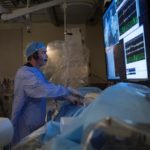
By Katherine Nazimek
Millions of Canadians experience irregular heart rhythms, known as arrhythmias; and, while many types of arrhythmias have no symptoms or warning signs, others may be life-threatening. In the more severe cases where lifestyle changes and medications aren’t enough to treat the irregularity, patients may undergo cardiac ablation to restore a normal heart rhythm.
Cardiac ablation is a procedure in which abnormal heart tissue is burned to create scar tissue that blocks stray electrical signals. Traditionally, during the non-surgical procedure, cardiac electrophysiologists use real-time, continuous X-rays (known as fluoroscopy) to guide their instruments into and around the heart; but a new technique is helping patients and medical staff avoid prolonged exposure to radiation during the procedure.
Sunnybrook Health Sciences Centre is one of few hospitals in Canada to adopt the new way of doing ablations using a three-dimensional mapping system called EnSite Precision™ cardiac mapping, which uses sensors, not X-rays, to provide highly detailed models of the heart.
How it works
During the ablation procedure, thin, flexible tubes with wires – called catheters – are inserted into the heart through small incisions in the skin. Diagnostic catheters record electrical information from the heart and display it on a screen in a three-dimensional model. The heart’s electrical pulses twinkle throughout the three-dimensional image, allowing the cardiologist to see any abnormalities. Abnormal tissue is then targeted using another catheter that has a specialized tip. The tip emits heat using high-frequency energy and creates a tiny scar that blocks the electrical signals causing the arrhythmia.

“When we move the catheters around the inside chamber of the heart, we build a map that allows us to see precisely – within a millimeter – what tissue we need to treat,” says Dr. Ben Glover, cardiac electrophysiologist at Sunnybrook’s Schulich Heart Program. “And because we are eliminating the need for fluoroscopy with this technology, we are eliminating the radiation that goes along with it.”
Not only does the new approach reduce radiation exposure to the patient, it also helps protect the medical staff who may be doing three of these multi-hour procedures in a single day.
“Conventional ablations have an immense effect on our health in the long-term. While there are strategies in place to ensure exposure is minimal, we – the physicians, the nurses, the anesthetists, the technologists – are all being exposed to X-rays to some extent during these procedures,” says Dr. Glover.
Studies show that during a 30-year career, cardiologists and other staff who work in catheterization laboratories have a cumulative radiation exposure of 50 mSv to 200 mSv, which is the equivalent of 2,500 to 10,000 chest X-rays. The impact is an increased risk of cataracts, cancer and other conditions linked to radiation.
It’s not just the radiation itself that affects the health of the medical team. Using traditional fluoroscopy, the staff within the catheterization lab need to wear heavy lead aprons for protection. These aprons can weigh up to 5 kg (11 lbs) and may be a contributor to orthopedic issues, like chronic back pain.
“There is considerable evidence that many electrophysiologists or cardiologists who perform these procedures report serious back problems and other musculoskeletal concerns that end up forcing them off work,” says Dr. Glover, adding that with the new approach, lead aprons would no longer be required.
Dr. Glover hopes more centres across Canada will use the fluoroscopy-free approach for the good of the patients and the staff.
Katherine Nazimek is a communications advisor at Sunnybrook Health Sciences Centre.


